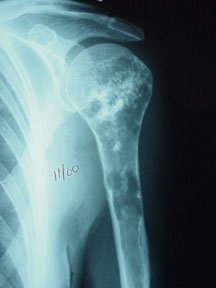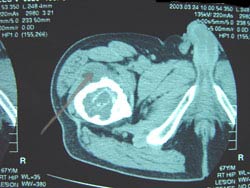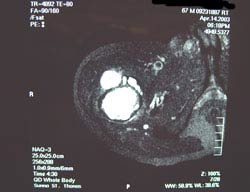Enchondromas vs. chondrosarcomas: tips for the orthopedic clinician
Enchondromas, cartilage remnants formed by cartilage analga, rarely turn into malignant lesions.
|
|
All of us who read bone X-rays occasionally will have a question in differentiating a routine enchondroma from a possible chondrosarcoma. To review the current thinking on this topic and to offer some potentially helpful tips for clinicians, I turned to Scott D. Weiner, MD, who is currently the chairman and residency director at Summa Health System in Akron, Ohio.
Douglas W. Jackson, MD: What are the current thoughts on the origin of enchondromas?
Scott D. Weiner, MD: Enchondromas are thought to be remnants of cartilage that persist into adolescence and adulthood that were originally a portion of the skeleton that was formed by cartilage analga. These rests of cartilage persist into adulthood and are commonly found serendipitously on staging studies for other problems. Most physicians think these benign enchondromas rarely convert into malignant lesions over time.
Jackson: Enchondromas are frequently seen in the orthopedist’s office on routine X-rays. What radiological findings suggest the need for further work up?
Weiner: This is a very good question as cartilage lesions are commonly found incidentally on X-ray evaluation. They typically appear as calcified lesions in the metaphysis of a long bone. When these lesions are found in the hand or foot and there is no evidence of cortical destruction, no further workup is necessary.
|
|
Chondrosarcomas are painful. The first thing an orthopedic surgeon must do is to evaluate the cause of the patient’s pain. My personal recommendation is for observation with a repeat X-ray in three to four months if the patient has no pain. If the patient has pain associated with the lesion, then evaluation for other causes of pain, ie, rotator cuff tendinitis or intra-articular derangement of the knee should be evaluated. If no other pain source is found, then I recommend a thin-cut CT scan with 3 mm cuts to clarify the calcification and to look for subtle evidence of soft tissue mass or cortical destruction. Often there is endosteal erosion but this has not been correlated directly with the diagnosis of chondrosarcoma.
An MRI could also be obtained for the suspicious lesion; the MRI will demonstrate subtle periosteal reactions or the soft tissue mass but does not characterize the calcification as well as a CT scan. If no soft tissue mass or periosteal reaction is identified, I recommend follow-up plain radiographs in three to four months to assess any changes in the calcification pattern. If radiographic change occurs, the baseline CT scan serves as a nice comparison for future CT scans. If any changes of the calcification pattern occur, ie, radiolucency develops, it must be assumed that this is a low-grade chondrosarcoma and should be treated. The treatment is somewhat controversial, as many orthopedic oncologists believe that low-grade chondrosarcomas are often overtreated with wide
resections and there has been a trend to do more conservative therapy with aggressive curettage and cementation similar to giant cell tumors. This is a controversial topic with no consensus in the U.S. oncology world.
If the initial radiograph shows cortical breakthrough, soft tissue mass, periosteal reaction or significant radiolucency (Figure 1), then further workup is indicated. Radiolucency associated with calcification suggestive of an enchondroma suggests a potential chondrosarcoma particularly in the face of pain.
Jackson: What clinical features help differentiate benign from malignant cartilage tumors?
Weiner: Night pain is characteristic of bone sarcomas. It is typically described as a deep, aching type pain unrelated to activity. That being said there is very common overlap between pain patterns. The initial thing that an orthopedic surgeon should do is evaluate for other causes of pain, ie, trigger point injections, subacromial injections, therapy, etc. to see if the pain can be relieved with an injection, which would not be the case for a chondrosarcoma. Further staging is necessary if the pain persists despite standard treatment for other causes.
Jackson: Can you use a bone scan to diagnose a problem? What are the roles of CT and MRI?
Weiner: The question of CT and MRI is answered above. They are typically used for signs cortical breakthrough, soft tissue evaluation and periosteal reaction, which are suggestive of chondrosarcoma. They can also be used as a baseline for follow-up studies if pain persists. Bone scans have been problematic in the work up of potential chondrosarcomas as they often show increased uptake in benign lesions as well as malignant lesions. Some authors have said that if the bone scan uptake is greater than 7 cm it is more suggestive of a chondrosarcoma. This is controversial and bone scans are not typically accepted as being valuable.
|
|

![Scott D. Weiner [photo]](/~/media/images/news/print/orthopedics-today/2005/12_december/weiner_216_278_4869.jpg)


